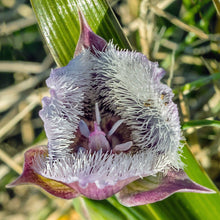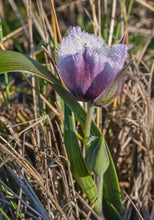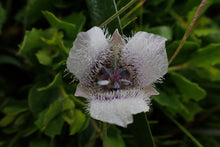Calochortus tolmiei
**PRODUCT NOTE - These bulbs will be available (in packs of 3) when you pick-up your plants in October. They cannot be pre-ordered since we will not know the total quantity available until the bulbs are dug in September. So, cross your fingers the voles lay off 'em and be sure to look for them at check out in October!
This is hands-down, one of the most striking and unique flowers to incorporate into your wildflower beds! A perennial bulb known by several common names; Tolmie's mariposa lily, star tulip, cat’s ear, or pussytoes will dazzle your meadowscapes and perennial borders each spring with its furry, white to light purple petals and exaggerated green sepals.
- Plant type/canopy layer: deciduous, perennial, herbaceous plant
- Size at maturity: 4"-18" tall, 0-12” wide
- Light requirements: full sun, part sun/part shade
- Moisture requirements: dry soil, prefers well-drained
- Bloom time: March - July
- Growth rate/ease: medium growth rate, easy to grow
- Wildlife support: flowers attract and provide nectar for adult butterflies, bees and other insect pollinators; overall plant is likely a host and larval food source for native sphinx moths
- Native habitat/range: found on dry open grassy slopes and woodland edges, from near sea level at the coast to mid elevations of the west-Cascades, across western portions of the Pacific Northwest. Portland Plant List - yes
- Special features & uses: landscape uses include meadowscapes, pollinator gardens, rock gardens and woodland edges
Gardening with Tolmie’s Mariposa: Simply give this stunner full to part sun and sandy or loamy soils that are dry and well-drained soil. and Once established, the plant is drought tolerant and doesn't require any supplemental water to intensely beautify your wildflower meadowscapes and woodland borders. In fact, like most bulbs, once planted in the landscape, it needs to stay dry in the summer months and can easily rot if accidentally irrigated. Bulbs are also generally susceptible to predation from several types of small mammals but are so gorgeous that they are well-worth the risk! Plant in multiples to increase your chance of success.
Planting Instructions:
- Fall Bulbs - Plant bulbs in fall, about 5" deep and 6" apart with the pointed end up and the root fragments facing down. Cover with soil and water thoroughly. In the short term, consider placing a physical barrier (like a black plastic flat or the saucer for under a flowerpot) directly on top to deter small mammals from immediately digging it up.
- Spring Containers - Depending on the weather and the date of your order pick-up, bulbs may be just emerging or already dying back for the season. Bulbs can be fragile when they're actively growing in spring. So, either plant with care or keep it in its pot and wait until it dies back entirely before planting. By early summer, the plant will die back completely and the bulb will be easy to transplant. If you go this route, leave the pot in a sheltered place and water sparingly, so that you don't rot the bulb.
Photo Credit 1 & 2: "Calochortus tolmiei" by John Game is licensed under CC BY 2.0
Photo Credit 3: "Calochortus tolmiei" by Madeleine Claire is licensed under CC BY 4.0.






